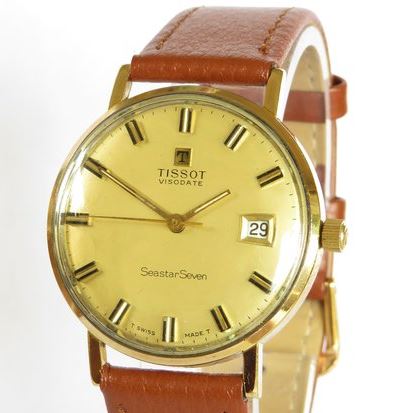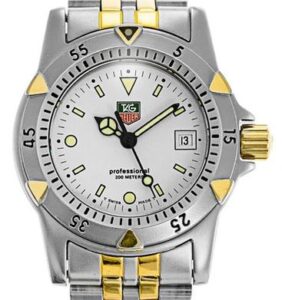Last Updated on May 1, 2024 by Jason
Made of acrylic, glass or synthetic Sapphire, the crystal is a transparent cover or lens that protects the vintage watch dial and reduces glare. As well as allowing you to read the time on your vintage watch, the crystal also protects the delicate inner components of your timepiece from damage. It is one of the most fragile components of a vintage watch and is susceptible to damage from impacts, such as dropping the watch from a height onto a hard surface. Along with the crown, the crystal is one of the most likely external features to be unoriginal on a vintage watch. Even if you have managed to acquire a vintage watch with the original crystal, there is always the chance that it may break and require replacement in the future. In this post, we will explain the different types of vintage watch crystals that are commonly available.
What are the different types of watch crystals?
When choosing a replacement crystal for a vintage watch, typically there are three main choices: acrylic, mineral and sapphire. Each type offers its advantages and disadvantages, with varying costs associated. Regardless of which type you choose, it should be fitted by a professional to ensure the watch is fully protected from the elements, this helps to ensure your vintage watch remains reliable.
Acrylic glass
Acrylic glass, the cheapest among the three types, was first used in watch crystals in the 1920s. The exact date is hard to pinpoint, but it certainly became more common following the Second World War. Acrylic glass is actually plastic so it is flexible, transparent and very light. It is hard to shatter but gets scratched easily. Fortunately, the scratches can be easily removed if polished or buffed. While acrylic glass is relatively durable, it is not as tough as materials like sapphire crystal or mineral glass. It can be more susceptible to damage from impacts or accidental drops. Another disadvantage is that acrylic glass has lower heat resistance compared to mineral and sapphire crystals. Exposure to high temperatures can cause it to warp, melt, or even catch fire.
Over time, acrylic glass may become yellow or discoloured due to exposure to UV radiation, oils, and other environmental factors. Today, watchmakers usually use acrylic glass or plastic to make cheap watches, especially children’s watches. Acrylic glass, also known as polymethyl methacrylate (PMMA) or Plexiglas.
Mineral glass
The disadvantages of acrylic glass forced many watchmakers to look for a more durable solution. Mineral glass became the obvious solution. Mineral glass is the most common type of watch crystal to be found in original vintage watches. It ranks around 5 – 7 out of 10 on the Mohs hardness scale and is commonly used in domestic glass windows. Mineral glass is composed of a combination of silica and other minerals, typically including sodium, potassium, and magnesium. It is manufactured by heating the material to high temperature to form the glass, which is then rapidly cooled. This is followed by chemical treatments to enhance the strength and durability of the glass.
Mineral glass offers better durability and impact resistance than acrylic glass, although it isn’t as hard as sapphire crystal. However, under extreme hot and cold conditions, mineral glass may crack or shatter. If a mineral crystal is scratched or chipped, then it cannot be polished and “repaired”, it needs to be replaced. Unlike, acrylic glass, mineral glass does not yellow or discolour. Mineral glass provides excellent optical clarity, allowing for clear visibility of the watch dial.
Sapphire crystal
The third and most desirable glass type is sapphire crystal. Its outstanding resistance and clarity make it the perfect choice for luxury watches. Sapphire, rates 9 out of 10 on the Mohs hardness scale, making it one of the hardest substances on Earth, diamond is listed as 10. Realistically, sapphire glass can only be scratched by other sapphires or diamonds. Sapphire glass, also known as sapphire crystal or synthetic sapphire, is a transparent, synthetic material made from crystallizing aluminium oxide at very high temperatures. Synthetic sapphire does not have colour but has the same physical attributes as natural sapphire.
Sapphire glass was first used as a watch crystal in the early 20th century, but its use was limited due to the costs associated with manufacturing large, high-quality sapphire crystals. However, advancements in technology and manufacturing processes during the latter half of the 20th century reduced the costs significantly. The widespread adoption of sapphire glass in the watchmaking industry began in the 1980s and 1990s, particularly among luxury watch brands. These brands recognized the superior durability and scratch resistance offered by sapphire crystal. While sapphire crystal is more expensive to produce than mineral glass or acrylic, its durability and longevity make it a preferred choice for collectors who wear vintage watches.
Domed and flat sapphire crystals
As explained above, sapphire crystal is without a doubt the best watch glass. Additionally, it is worth knowing that sapphire crystals can be either domed or flat in design. The domed sapphire crystal is considered to be stronger than the flat version assuming the same thickness. This is because the domed sapphire crystal spreads the force over a greater area so it is less likely to shatter. Additionally, a domed sapphire crystal reduces the light reflection. However, domed sapphire crystal is much more expensive and can cause distortion when viewing from extreme angles. Flat crystals offer a sleeker more modern design.
What type of watch crystal do I have?
If you buy a modern watch from a reputable brand, you are always given clear information about the type of watch glass on the dial. However, with vintage watches, it is rare to receive the original paperwork and of course, the crystal could have been replaced at some point in time.
Being plastic, acrylic glass is totally unlike mineral glass or sapphire crystal. You can feel the difference when placing it against your skin. Acrylic glass is typically warm while mineral glass or sapphire crystal is cold.
To differentiate between mineral and sapphire crystals, there are two tests that watchmakers tend to apply. First, you can test using a drop of water on the glass. If the water stays in the drop shape, it is most likely a sapphire crystal. On mineral glass, the water will flow and spread. Second, there is also a sound test by tapping your fingernail on the glass. If the sound is solid and low-toned, it is sapphire crystal. If it is high toned, it will be mineral glass.


Leave a Reply